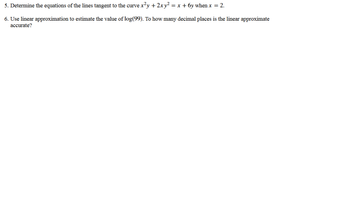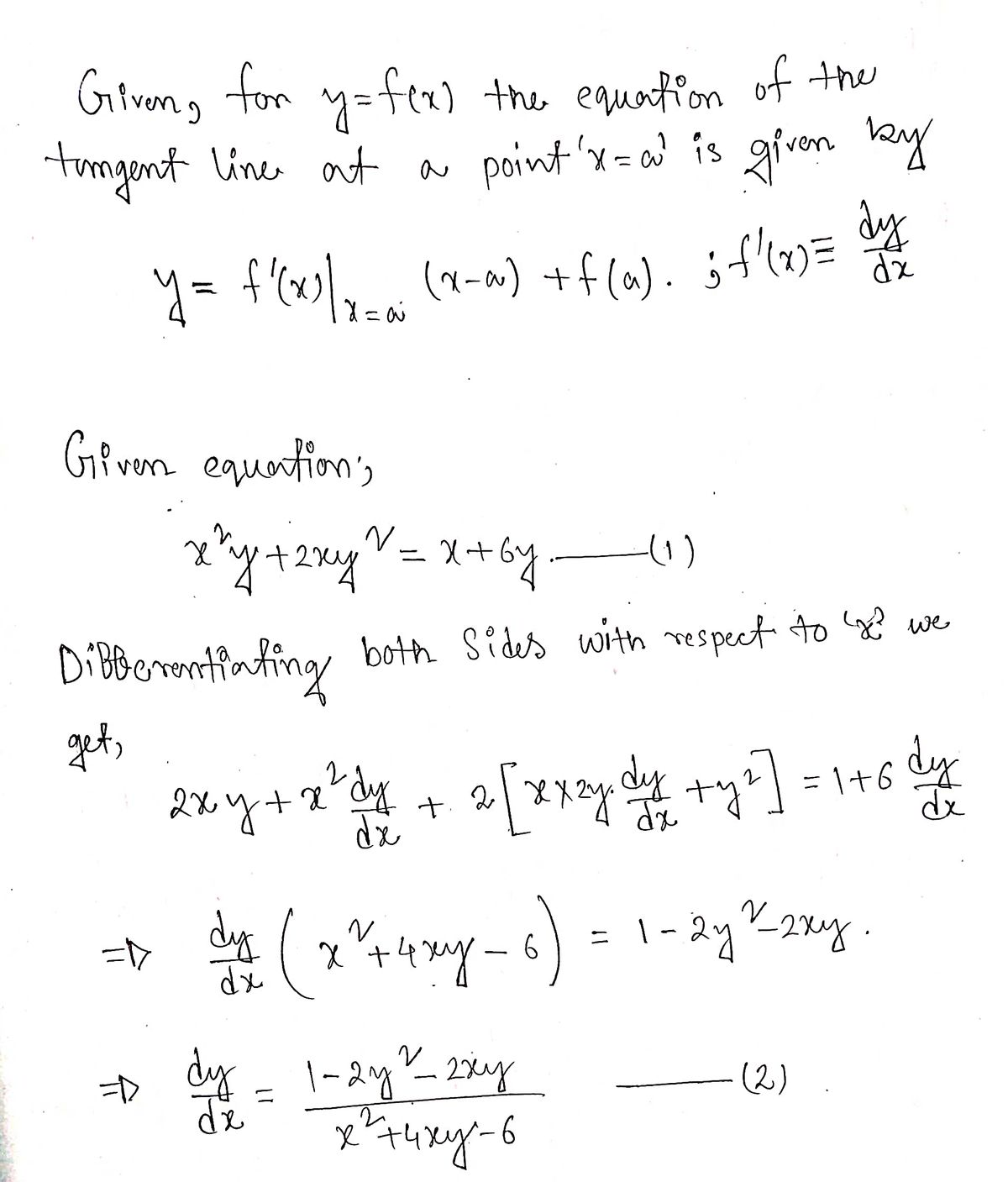
Advanced Engineering Mathematics
10th Edition
ISBN: 9780470458365
Author: Erwin Kreyszig
Publisher: Wiley, John & Sons, Incorporated
expand_more
expand_more
format_list_bulleted
Question
Hi, I need help with this. Please only use the formulas I have provided. Please write it so that I can read it! Thank you so much!
![# Multiple Derivatives
A function \( f \) is \( n \)-times differentiable (or \( f \in C^n \)) if you can apply the derivative \( n \) times to \( f \) and have a continuous function after each application of the derivative.
A function \( f \) is smooth (or \( f \in C^\infty \)) if it can be differentiated infinitely many times, and each derivative is a continuous function.
## Derivative Properties
**Linearity:**
\[
\frac{d}{dx} [f(x) + a \cdot g(x)] = f'(x) + a \cdot g'(x)
\]
**Products:**
\[
\frac{d}{dx} [f(x)g(x)] = f'(x)g(x) + f(x)g'(x)
\]
**Quotients:**
\[
\frac{d}{dx} \left[ \frac{f(x)}{g(x)} \right] = \frac{f'(x)g(x) - f(x)g'(x)}{(g(x))^2}, \quad \text{where } g(x) \ne 0
\]
**Compositions:**
\[
\frac{d}{dx} [f(g(x))] = f'(g(x)) \cdot g'(x)
\]
## Tangent and Normal Lines
If \( y = f(x) \) describes some differentiable function, the equation of the tangent line at a point is given by
\[
y = f'(a)(x - a) + f(a).
\]
The equation of the normal line at a point is given by
\[
y = -\frac{1}{f'(a)}(x - a) + f(a).
\]
## Linear Approximation
If \( f \) is differentiable near \( a \), then for values \( x \) close to \( a \),
\[
f(x) \approx f(a)(x - a) + f(a).
\]
# Basic Function Derivatives
- **Constant:**
\[
\frac{d}{dx} [a] = 0, \quad \text{where } a
\]
- **Power:**
\[
\frac{d}{dx} [x^r] = r \cdot](https://content.bartleby.com/qna-images/question/f4b0f97a-89e5-4466-a6e2-73ccf61a13a9/3ab0f606-1d2c-4166-be4e-b6cdf34992e9/pmb4kt7_thumbnail.png)
Transcribed Image Text:# Multiple Derivatives
A function \( f \) is \( n \)-times differentiable (or \( f \in C^n \)) if you can apply the derivative \( n \) times to \( f \) and have a continuous function after each application of the derivative.
A function \( f \) is smooth (or \( f \in C^\infty \)) if it can be differentiated infinitely many times, and each derivative is a continuous function.
## Derivative Properties
**Linearity:**
\[
\frac{d}{dx} [f(x) + a \cdot g(x)] = f'(x) + a \cdot g'(x)
\]
**Products:**
\[
\frac{d}{dx} [f(x)g(x)] = f'(x)g(x) + f(x)g'(x)
\]
**Quotients:**
\[
\frac{d}{dx} \left[ \frac{f(x)}{g(x)} \right] = \frac{f'(x)g(x) - f(x)g'(x)}{(g(x))^2}, \quad \text{where } g(x) \ne 0
\]
**Compositions:**
\[
\frac{d}{dx} [f(g(x))] = f'(g(x)) \cdot g'(x)
\]
## Tangent and Normal Lines
If \( y = f(x) \) describes some differentiable function, the equation of the tangent line at a point is given by
\[
y = f'(a)(x - a) + f(a).
\]
The equation of the normal line at a point is given by
\[
y = -\frac{1}{f'(a)}(x - a) + f(a).
\]
## Linear Approximation
If \( f \) is differentiable near \( a \), then for values \( x \) close to \( a \),
\[
f(x) \approx f(a)(x - a) + f(a).
\]
# Basic Function Derivatives
- **Constant:**
\[
\frac{d}{dx} [a] = 0, \quad \text{where } a
\]
- **Power:**
\[
\frac{d}{dx} [x^r] = r \cdot

Transcribed Image Text:### Calculus Problems
**5. Determine the equations of the lines tangent to the curve \( x^2y + 2xy^2 = x + 6y \) when \( x = 2 \).**
For this problem, you'll need to find the derivative of the implicit function to determine the slope of the tangent line at the specified point \( x = 2 \). Then, use the point-slope form of the equation of a line to find the tangent line equations.
---
**6. Use linear approximation to estimate the value of \( \log(99) \). To how many decimal places is the linear approximation accurate?**
In this task, apply the concept of linear approximation around a nearby easy-to-calculate value, such as \( \log(100) \), and find the linear approximation of \( \log(99) \). Determine the accuracy by comparing it to the actual value.
Expert Solution
arrow_forward
Step 1

Step by stepSolved in 4 steps with 4 images

Knowledge Booster
Similar questions
- Please describe the answers step by step since it is difficult to figure it out since the answers are cut off.arrow_forwardCould you use formulas instead of tables? pleasearrow_forwardI am not quite sure what you did in this question even though the answer is right. Is it possible to use a pen instead of typing ? That can be a great help. Thanks.arrow_forward
- Please Explain Clearly because I'm having a hard time understanding this material?arrow_forwardCan you please show how the math is done in one of the calculations, I cannot figure out what is being done? Thanksarrow_forwardSolve this question by formulas only no excel or any software. please and thank youarrow_forward
arrow_back_ios
arrow_forward_ios
Recommended textbooks for you
 Advanced Engineering MathematicsAdvanced MathISBN:9780470458365Author:Erwin KreyszigPublisher:Wiley, John & Sons, Incorporated
Advanced Engineering MathematicsAdvanced MathISBN:9780470458365Author:Erwin KreyszigPublisher:Wiley, John & Sons, Incorporated Numerical Methods for EngineersAdvanced MathISBN:9780073397924Author:Steven C. Chapra Dr., Raymond P. CanalePublisher:McGraw-Hill Education
Numerical Methods for EngineersAdvanced MathISBN:9780073397924Author:Steven C. Chapra Dr., Raymond P. CanalePublisher:McGraw-Hill Education Introductory Mathematics for Engineering Applicat...Advanced MathISBN:9781118141809Author:Nathan KlingbeilPublisher:WILEY
Introductory Mathematics for Engineering Applicat...Advanced MathISBN:9781118141809Author:Nathan KlingbeilPublisher:WILEY Mathematics For Machine TechnologyAdvanced MathISBN:9781337798310Author:Peterson, John.Publisher:Cengage Learning,
Mathematics For Machine TechnologyAdvanced MathISBN:9781337798310Author:Peterson, John.Publisher:Cengage Learning,


Advanced Engineering Mathematics
Advanced Math
ISBN:9780470458365
Author:Erwin Kreyszig
Publisher:Wiley, John & Sons, Incorporated

Numerical Methods for Engineers
Advanced Math
ISBN:9780073397924
Author:Steven C. Chapra Dr., Raymond P. Canale
Publisher:McGraw-Hill Education

Introductory Mathematics for Engineering Applicat...
Advanced Math
ISBN:9781118141809
Author:Nathan Klingbeil
Publisher:WILEY

Mathematics For Machine Technology
Advanced Math
ISBN:9781337798310
Author:Peterson, John.
Publisher:Cengage Learning,

